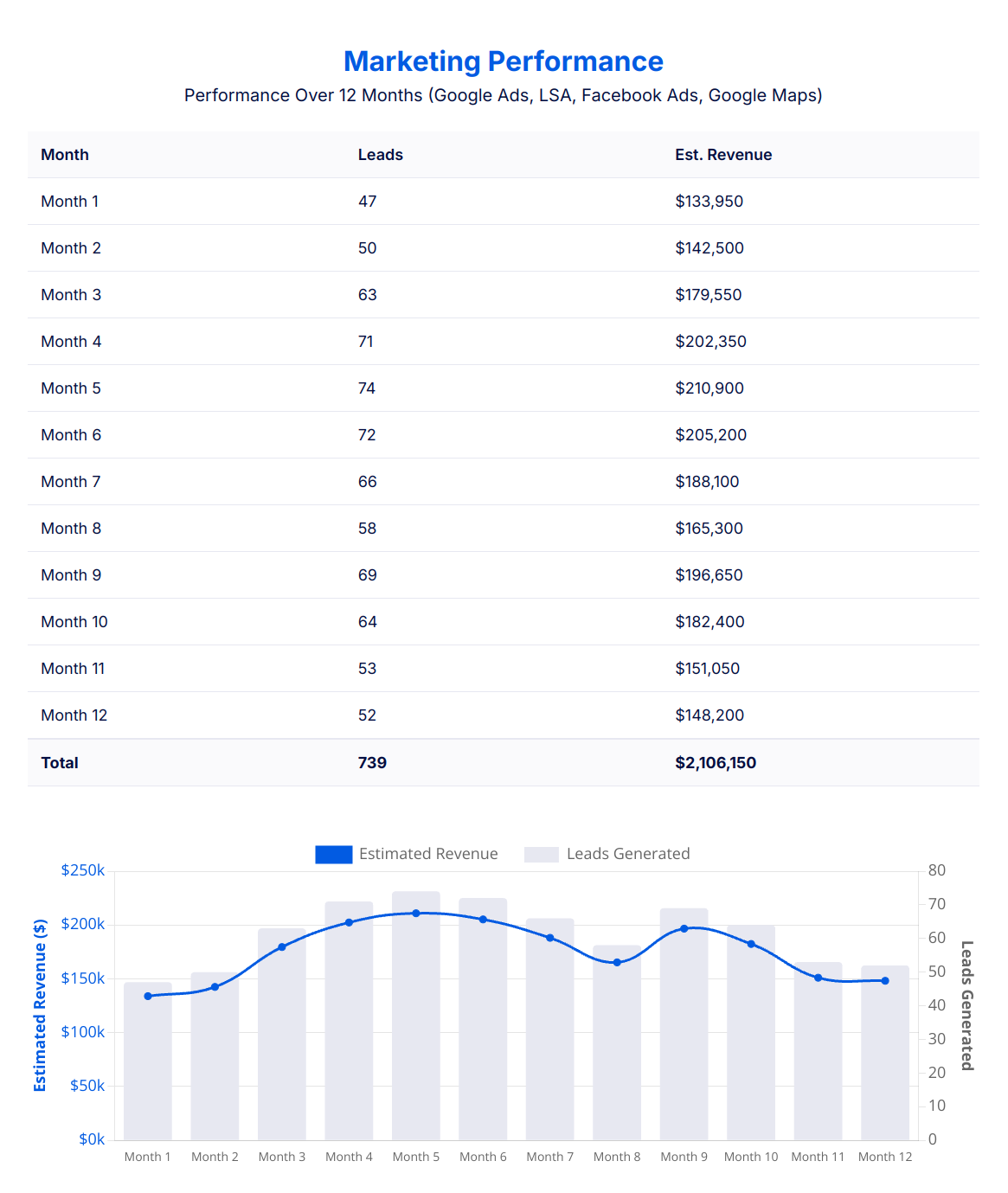How We Generated 739 Leads and $2.11 Million for a Los Angeles Remodeler
Industry
Remodeling
Services
CyberEngine™ Full-Service Growth
First 12 Months
Additional Metrics

About the Client
This client is a premium Los Angeles remodeling firm serving residential homeowners and select small-commercial projects. With five highly skilled crews, they specialize in kitchens, baths, additions, and ADUs (Accessory Dwelling Units) across some of the city’s most desirable neighborhoods. Their hallmark is a blend of craftsmanship, strong warranties, and a project management process designed to keep homes livable throughout construction. They position themselves as a quality-first provider, not the lowest bid, and they excel when prospects quickly trust their expertise and communication.
Before partnering with us, the company’s lead flow was unpredictable—swinging from periods of overwhelming demand to weeks of minimal activity. Referrals remained strong, but paid traffic delivered inconsistent results. The office team juggled jobsite coordination with sales follow-up, creating a feast-or-famine pipeline that disrupted scheduling, complicated material orders, and occasionally forced discounting to keep crews engaged.
Their goals were direct and uncompromising: generate consistent, high-value demand year-round, preserve a premium brand image, and expand profitable small-commercial work without lowering standards. They wanted marketing that could prove its direct impact on booked projects, a website that inspired trust within seconds, and a growth system they could scale without sacrificing the client experience that fuels their referral business.
Challenges
First, the market: Los Angeles remodeling is hyper-competitive, with high search costs and intense local rivalry. Local Services Ads—Google’s pay-per-lead advertising platform that appears above standard search ads—dominate prime visibility. Competitors use financing offers and long warranties to raise homeowner expectations, which drives up cost-per-click (the price paid each time someone clicks an ad) on core terms. Without clear positioning and precise targeting, extra activity only adds noise rather than producing better opportunities.
Second, the tech stack: The legacy Google Ads account relied heavily on broad match keywords—a setting that shows ads for loosely related searches—along with overlapping terms and few negative keywords (terms that prevent ads from showing for irrelevant searches). Conversion tracking—measuring calls, form submissions, and chat inquiries—was incomplete, so campaigns were optimized for cheap traffic instead of qualified leads. There were no call recordings to coach staff, and micro-conversions such as click-to-call on mobile were untracked, leaving valuable data invisible to the system.
Third, the website: Mobile load times lagged, messaging was unclear, and calls-to-action sat below the fold (requiring scrolling). Trust signals—reviews, galleries, licensing—were inconsistent. Core Web Vitals—Google’s benchmarks for site speed and stability—failed on mobile, hurting both rankings and ad quality. Forms demanded too much information, live chat was offline during peak hours, and residential and commercial content were combined on the same pages, diluting relevance for both.
Finally, timing and geography: Campaigns ignored day-part patterns—variations in user activity throughout the day—and lacked seasonal planning to anticipate demand spikes in spring and early summer. Reporting did not link marketing channels to booked revenue, leaving leadership to forecast staffing and purchasing by intuition rather than data.
Strategy and Solution
The client selected our CyberEngine™ Full-Service Growth program—a unified marketing operating system that integrates paid ads, local SEO, website optimization, and reputation management into a consistent growth rhythm. We began with a measurement plan tied directly to revenue, ensuring that success was defined by booked projects rather than vanity metrics like clicks or impressions. We set north-star metrics—primary targets that guide all activities—for inquiries, qualified appointments, and closed revenue, aligning marketing objectives with operational capacity.
We created a single source of truth by connecting analytics tools with the client’s CRM (Customer Relationship Management) system. Dynamic call tracking assigned each phone call to its originating campaign, while Local Services Ads leads were automatically synced. Every form submission and chat interaction was tracked, and attribution—the method of assigning credit for a lead to a specific source—was standardized. Weekly scorecards replaced scattered reports, and speed-to-lead protocols, including instant missed-call alerts, ensured that inquiries received a rapid response.
In Google Ads, campaigns were rebuilt around service intent—the specific reason someone is searching. We replaced broad matches with tighter match types to control relevance, expanded negative keyword lists to filter out poor-quality searches, refreshed ad copy, and redesigned landing pages to boost quality score (Google’s measure of ad relevance and landing page experience) and conversion rate (the percentage of visitors who become leads). Campaign schedules were aligned with peak browsing hours, brand terms were protected, and internal bidding conflicts were removed.
For Local Services Ads, we optimized profile details, refined service categories, and increased review velocity—the rate at which new customer reviews are collected. We implemented lead-dispute workflows to remove spam or mismatched jobs, and we trained office staff to answer promptly and qualify prospects consistently. Recorded calls were monitored to reinforce best practices and improve appointment-setting skills.
The website and local SEO received a full overhaul. Pages were rebuilt for faster load times and clear messaging. Dedicated service pages, neighborhood-focused content, and detailed project galleries improved relevance and engagement. The Google Business Profile—the listing that powers Google Maps—was strengthened for map-pack visibility, a key source of high-intent leads. Schema markup (structured code that helps search engines understand page content) and improved internal linking boosted topical authority. Prominent proof elements—licenses, process visuals, and warranties—were made impossible to miss.
Finally, we launched Meta (Facebook) retargeting to re-engage past visitors. Offers promoted design consultations and a downloadable remodeling guide. A/B tests compared ad variations to find top performers, frequency caps prevented overexposure, and always-on campaigns kept the brand visible. Email follow-up sequences nurtured leads with project timelines, budgeting insights, and portfolio highlights.
Results
Over the first 12 months, the program generated 739 qualified leads. With a 19% close rate, this resulted in roughly 140 booked projects. At an average job value of $15,000, that’s $2.11M in attributable revenue—a consistent, reliable pipeline rather than a short-term spike. Crew schedules stayed full, purchasing could be planned in advance, and the need for discounting during slower weeks was eliminated. The sales team saw a higher share of design-build consultations that progressed directly to estimates.
Leads came from a balanced mix of Google Ads, Local Services Ads, Google Maps, and Meta (Facebook) Ads. This diversification protected against channel fluctuations and ensured steady demand. The team concentrated on high-margin opportunities, improved appointment-kept rates (the percentage of booked meetings that occur), and reduced the time from inquiry to estimate. Speed-to-lead protocols, paired with consistent qualification, meant sales staff spent more time with well-matched homeowners.
Organic search presence strengthened across targeted neighborhoods. Visitors spent more time on-site, and bounce rates declined—clear indicators of message-to-market fit. Updated project galleries, process visuals, and reviews acted as silent sales assets, building trust before the first conversation. Optimized Maps listings supplied a dependable flow of high-intent calls from homeowners ready to schedule.
Performance aligned with natural seasonality: strong peaks in late spring and early summer, lighter activity during holidays. With accurate forecasting, leadership could plan staffing, order materials with long lead times, and schedule showroom appointments without guesswork. Encouraged by results, the client renewed for a second year with plans to scale residential design-build and expand profitable small-commercial work while maintaining their premium positioning.
Want a Clear Plan to Grow Your Business?
Schedule your free Business Growth Consultation with our experts. Together, we’ll evaluate your current situation, uncover opportunities, and create a strategy designed to achieve your goals. No guesswork - just a roadmap you can act on immediately.
Schedule My Free Consultation.svg)

.svg)



.svg)